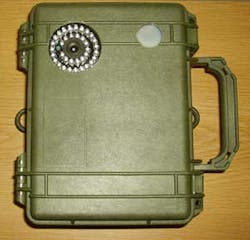Putting Surveillance in Remote, Outdoor Locations
Video surveillance has long been an outstanding tool for security and law enforcement, but there were places where you just couldn't put cameras and recorders.
Mainly that was outdoor surveillance, where lack of power, and weather conditions played havoc with surveillance systems. Special enclosures were designed by companies like Pelco to overcome the issues, and heaters and fans were added to keep sensitive equipment working. But the one thing that remained was that all such systems required power. Additionally, spinning discs and gears, like those in traditional DVRs and VCRs respectfully, don't fare well to temperature changes and issues of moisture.
Certainly, there were hardened outdoor systems that specialty vendors had created, but they still had limitations.
"We have had an outdoor video system that has cellular capabilities to send video clips," explains Mark Ellsworth, vice president of sales at Smarter Security, "but even though it's an outdoor unit, it still required power. What we saw was that people from the park service, wildlife and game agencies, law enforcement and even ranchers were coming to us and they had something they needed to catch on video, but they couldn't provide power in the area they needed."
Ellsworth's company went out to solve that problem and recently announced the launch of its Smarter DVR 100, a self-enclosed weatherproof unit with camera, battery power and recording device built into the unit.
The unit, which retails for $1,495, uses a heat-based motion sensor to turn on the camera and flash memory-based recording device (no spinning parts), and it takes about 4 seconds to have the system up and running. The Smarter DVR 100 camera/recorder unit captures and records video at 640x480 resolution, at 30 frames per second. It shuts off when motion stops, and can be pre-configured for certain segment lengths. The internal 4Gb flash memory card can store about 4,000 video clips, says Ellsworth, but it's unlikely the battery would last that long. Users can recharge the battery off-site with an A/C charger, or on-site with an optional ($150) solar panel kit. The camera is ringed with IR LEDs to allow it to see in the dark (Ellsworth says 30 to 40 feet is easily obtained) and can be used during the day as a color camera as well. A plastic, hardened box keeps the unit waterproof, and there's even an option to add audio recording when the video is being recorded.
Due to the fact that users will need to remove cards to get the data and may need to occasionally recharge batteries (the solar system extends the device's battery life, but not indefinitely), such systems are generally applicable only for temporary installations. They can be set up quickly to target areas where vandalism has started, and because the units are silent, they work also for rural and wild environments where they can be mounted in trees for partially-covert surveillance.
This type of technology, says Ellsworth, is especially good at night, when temperatures drop and the PIR sensor can better distinguish motion. Cold (tested down to 0 degrees Fahrenheit), cool and warm environments work well for the PIR sensor-activated system, though hot, sun-baked temperatures which might be found in the Southwest U.S. make it more difficult for the PIR to detect motion.
Our prediction: Security users will find places to use this kind of technology where they'd always dreamed of having a camera, but couldn't justify the installation cost or find a way to get power there.
New Technology Helping to Enable Remote Outdoor Surveillance
Flash memory: This is the same type of memory you probably have in your digital camera. It saves pictures or video clips on a chip that is the size of a thumbnail, and can be removed from the device quickly. Best of all, there are no moving parts.
Better batteries: New battery technology like NiMH or Lithium Ion may be a benefit to remote systems. Both battery types are rechargeable hundreds (even thousands) of times and can provide a good deal of power.
Infrared LEDs on Cameras: Infrared-light-producing LEDs have dropped in price and are low on power consumption and not particularly affected by the weather, making them ideal for outdoor video surveillance applications
Solar panels: These panels are becoming more and more common in outdoor environments, especially as the prices drop and the panel quality increases.
